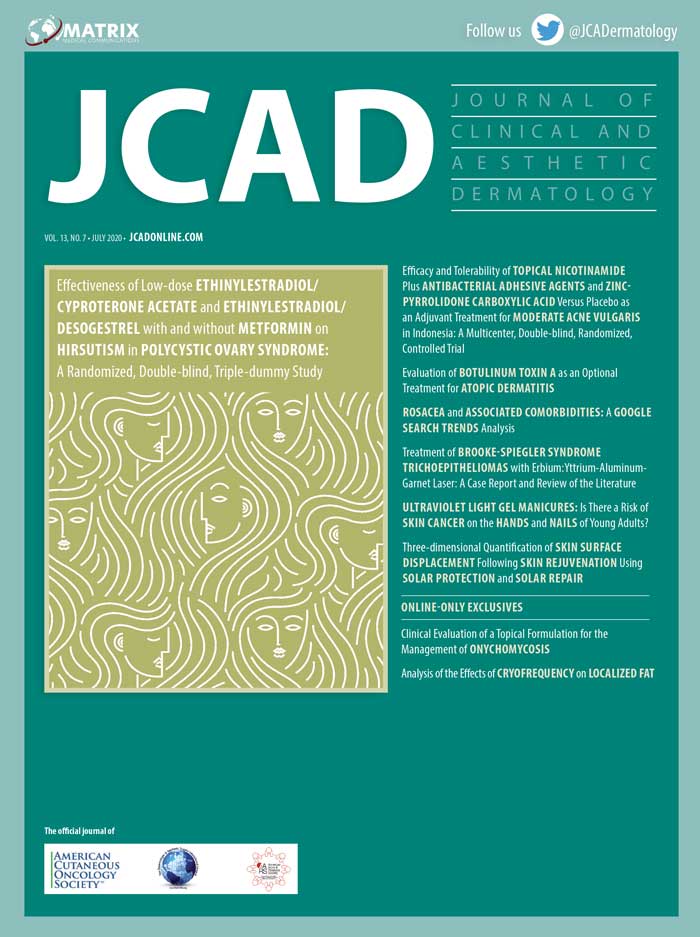Vol. 13, No. 7 • July 2020
 Dear Colleagues:
Dear Colleagues:
Welcome to the July 2020 issue of The Journal of Clinical and Aesthetic Dermatology. We begin the issue with an , in which the authors examine the effects of ethinylestradiol (35ug)/cyproterone acetate (2mg) (EE/CPA) and ethinylestradiol (20ug)/desogestrel (0.15mg) (EE/DES), alone or with metformin, on hirsutism in patients with polycystic ovary syndrome. In this randomized, double-blind, triple-dummy study that included 107 women with PCOS and hirsutism, the participants received one of four drug combinations (Arm A: EE/CPA; Arm B: EE/DES; Arm C: EE/CPA plus metformin; or Arm D: EE/DES plus metformin). Hirsutism was assessed at baseline, six months, and 12 months. At 12 months, the authors measured a significant reduction in both hair density and modified Ferriman-Gallwey (mFGS) score in Arm A, mFGS in Arm B, hair density in Arm C, and diameter of sideburn hair in Arm D.
Next, in an original research article by Sitohang et al, the authors investigated the efficacy and tolerability of nicotinamide cream plus an antibacterial adhesive agent and zinc-pyrrolidone carboxylic acid compared to placebo as an adjuvant therapy for moderate acne vulgaris (MAV) when used with adapalene. The study included 140 patients with MAV, aged 12 to 50 years, who were enrolled and randomly divided into two groups to receive either adapalene and the study formulation or adapalene and a placebo cream twice daily for six weeks. A significant decrease in the number of noninflammatory lesions in the second week was noted in the study group compared to in the placebo group.
After this, Khattab reports results from her prospective, intrapatient, left-to-right, randomized, placebo-controlled study in which she examined the efficacy of botulinum toxin A (BTX-A) as a treatment for atopic dermatitis. The study included 26 patients with atopic dermatitis (12 males and 14 females) with an average age of 37.8 years. Responses to therapy were assessed using SCORAD, Dermatology Quality of Life Index (DLQI), and the worldwide clinical reaction score evaluation. Mean SCORAD values dropped from 50.5 to 11 points (p<0.001) and 64.1 percent of patients reported an excellent response (76%–100% improvement). The DLQI score fell by 10.15 points (43.5%) in patients treated with BTX-A and a statistically significant reduction in SCORAD and DLQI scores occurred relative to in the placebo group (p<0.001).
Following this, Marchitto and Chien report results from their analysis of data collected from Google Trends to identify correlations in Google searches for rosacea and comorbid conditions to assess whether the public is seeking information regarding these trends. Google search data from January 1, 2004, to February 28, 2018, for rosacea and search terms representing common comorbid conditions were investigated. This analysis included searches occurring in the United States (US), Canada, the United Kingdom (UK), and Australia. Significant correlations were found between depression and rosacea search volume index (SVI) in the US, dementia and rosacea SVI in the UK, and hypothyroidism and rosacea SVI in the UK. Additionally, search trends for irritable bowel syndrome and ulcerative colitis correlated significantly with rosacea in Canada and the UK, respectively. In Australia, search trends for osteoporosis significantly correlated with rosacea.
Next, Thomas et al present the case of 28-year-old woman with Brooke-Spiegler Syndrome (BSS) with multiple trichoepitheliomas who was successfully treated with erbium:yttrium-aluminum-garnet (YAG) laser therapy. The authors also review similar cases of BSS treated with a YAG laser modality.
After this, in a literature review by Schwartz et al, the authors assess evidence in the literature regarding the incidence of skin cancer on the hands and nails of young adults who receive gel manicures cured by ultraviolet light. The review focused on patients aged 40 years or younger with a history of gel manicures diagnosed with nonmelanoma or melanoma skin cancers on the dorsum of their hands and nails. The authors found no cases of patients younger than 40 years with a history of chronic gel manicures diagnosed with nonmelanoma skin cancer or melanoma on the dorsum of the hands or nail matrices.
Finally, in an original research article from Tanaka et al, the author presents the results of a study (N=20) which investigated the effectiveness of a skincare regimen for skin rejuvenation that employs comprehensive solar protection, ranging from ultraviolet through to near-infrared radiation, and nightly repair of photodamage, and compared these results to other lifting medical procedures. A superimposed three-dimensional volumetric assessment and quantification of three-dimensional skin surface displacement with vectors were performed at baseline and after six months of treatment with the topical skincare products. Improvements in skin texture and clarity as recorded via digital photography and volumetric reduction was observed relative to pretreatment in all patients. Most vectors suggested three-dimensional skin surface displacement at the forehead, lateral sides of the cheek, and around the chin.
We hope you enjoy this issue of JCAD. As always, we welcome your feedback and submissions.
With regards,
James Q. Del Rosso, DO, FAOCD—Editor-in-Chief, Clinical Dermatology
Wm. Philip Werschler, MD, FAAD, FAACS—Editor-in-Chief, Aesthetic Dermatology
Seemal R. Desai, MD, FAAD— Associate Editor

